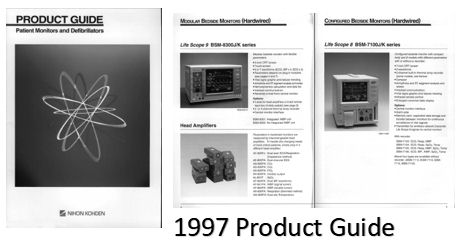Category:
NIHON KOHDEN (日本光電) Life Scope monitoring history from the 1990s, Life
Scope monitors networking; Nihon Kohden Life Scope BSM-8000
series bedside monitors, Life Scope S (BSS-9800) bedside station, Life Scope M (BSM-9501)
modular monitor, Life Scope J (BSM-9101) bedside monitor, Life Scope TR (BSM-6000 series) bedside monitor, Life Scope G5 (CSM-1500 series) bedside monitor, Life Scope
G7 (CSM-1700 series) bedside monitor, Life Scope G9 (CSM-1901) bedside monitor.
In
this record we traced the reasons for the perpetual struggle by NIHON
KOHDEN with the disruptive digital revolution since the 1990s, and this is still current ongoing (but unacknowledged) dire situation! The incompetence to complete a comprehensive real-time digital communication networks for the Life Scope Patient
Monitors led to denial and taking ill-considered risks in exporting unproven new-type biphasic defibrillators in November 2002. Subsequent events were even incomprehensible, it is now a ticking time bomb waiting to explode with many key issues unaddressed.
The
detailed chronological events that led to NIHON KOHDEN giving up the development work to make digital modular monitors should surprise many, given
the great efforts put in to hide this poor state of affairs; to move forward positively, the absurdity highlighted in this article must be first set
right.
(I)
Back To The Future In The 1990s
The longer you can look back, the farther you can look forward - Winston Churchill
The Digital Revolution dealt not only a heavy, but lasting blow to NIHON KOHDEN as a manufacturer
First, for perspective: The highest revenue for NIHON KOHDEN CORPORATION from exports comes from patient monitors, followed by defibrillators, together they formed more than 70% of the company's sales in foreign markets. All other products contribute only a small part to the export business.
The disruptive digital revolution brutally pushed back by decades the technological progress of NIHON KOHDEN, whose strength is mainly in traditional analog electronics; many of you will be stunned to learn what is the company's current digital capability for patient monitoring. The details are available in this article for your critical evaluation.
During the 1990s, the company was seen grappling with a huge technological gap to catch up with International players; the overall situation was so bad that an overhaul of the entire product range was needed. Speed and intense investment were the two critical elements to make up for the lost time but the company relented after encountering the first failures. NIHON KOHDEN had lost the opportunity to catch up, and the company is way far behind international competitors today.
When digital Ethernet networking had become the norm in foreign markets, Nihon Kohden
Corporation
in Japan was still helplessly struggling with the outdated analog type signal
exchangers. The only reason the company is still around today is due to the fact Japanese domestic market for medical equipment is a protective one, and domestic companies are insulated from competing directly with foreign companies on the basis of technologies.

| NIHON KOHDEN patient monitoring products were shunned in foreign markets |
|---|
The problem faced by the company in foreign markets has always been how to create value using outdated technology! The absence of know-how to offer even basic level of digital networking (LAN) in
Patient Monitors in the 1990s meant
the collapse of NIHON KOHDEN export sales for Life Scope Patient
Monitors; the only exception was export sales linked to Japanese Government ODA projects. As seen in the USA
market, sales recovery was so gradual and hardly noticeable that many
from the
younger generation had erroneously mistaken it as a new
emerging brand in the market!
For a
good SUMMARY of the Patient Monitoring market up to the late 1980s,
Michael E. Porter had one in his book The Competitive Advantage of Nations (1990; Republished with a new introduction, 1998).
From the early 1990s the Life Scope Patient Monitoring Systems had already shown rapid technological irrelevance. In August 1998, Nihon Kohden finally launched the first Life Scope modular monitor using a digital interface between monitor main unit and modules, but this turned out to be a failure and the company lost the willpower to continue.
From the early 1990s the Life Scope Patient Monitoring Systems had already shown rapid technological irrelevance. In August 1998, Nihon Kohden finally launched the first Life Scope modular monitor using a digital interface between monitor main unit and modules, but this turned out to be a failure and the company lost the willpower to continue.
It was only five years later, in September 2002, through the examination of a new Life Scope A series monitors could any observer confidently conclude the poorly-designed network platform for digital
measurement data was already abandoned and everything from then on are just for show.
Instead of confronting it squarely as a representative patient-monitoring brand from Japan, the
company kept busy thinking about all the means possible to hide their incompetence for scalability of patient-monitoring parameters using digital networking. The analog yellow common-use multi-parameter sockets were chosen to pass off absurdly as digital nodes connecting to a non-existent measurement data network platform.
| The types of backward and embarrassing patient monitoring products NIHON KOHDEN was exporting in 1997 |
|---|
Take a look at this scanned copy of the Nihon Kohden 1997 Product Guide (click for PDF),
the booklet contained the details of CardioLife TEC-2200 series
defibrillators which were officially launched in May 1997, thus May 1997
sets the earliest possible publication date of this product guide beyond the
slightest doubt.
The patient monitors in the said guide show product details of Life Scope 9, Life Scope 14, Life Scope LC etc. linking to CNS-8300 Central Monitors via bulky analog signal exchangers instead of compact digital network hubs.
Information about USA
FDA registrations during this period for Nihon Kohden patient monitoring products are readily accessible on the Internet.


